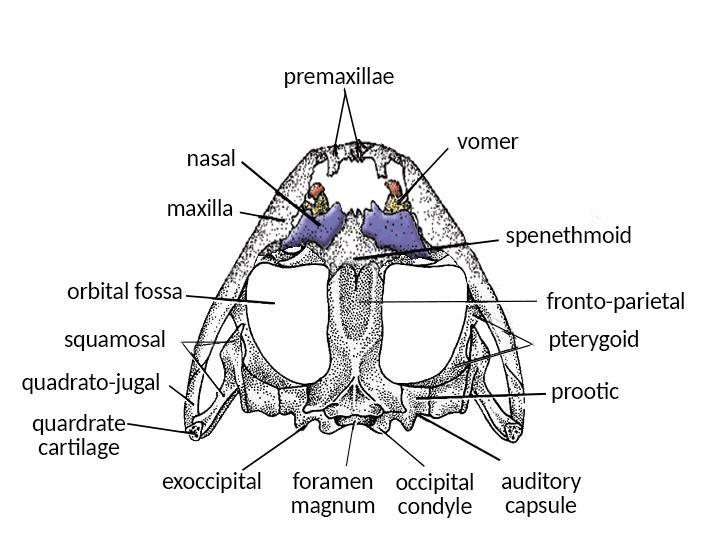
Answer
391.5k+ views
Hint: In small vertebrates that require water or a moist atmosphere to live, the Dicondylic skull is present. Frogs, toads, salamanders, and newts are the species in this group. On land or sea, they can live.
Complete step by step answer:
Dicondylic skulls are known as the skull, which is connected to the body with two articulatory condyles. It is present in mammals and amphibians.
The skull has two occipital condyles in amphibia, and the skull is bound by the first vertebra of the vertebral column, i.e., atlas, with the aid of these two condyles. The round prominence at the end of a bone which forms an articulation with another bone is a condyle.
Typically, living amphibians have drastically reduced skulls, with many of the bones either missing or substituted by cartilage wholly or partially. The pedicellate teeth are seen in the skull, a trait of all amphibians. Most of their skulls are large and short, and they are also incompletely ossified. Given is the diagram of a frog skull:

So, the correct answer is, ‘(a) Amphibians’.
Additional information:
Monocondylic means a skull having a single condyle on the occipital. The Skull of reptiles is an example of this type.
Birds have only one occipital (monocondylic) condyle and can thus rotate up to 270 degrees in their heads.
- Amphibia has a dicondylic skull.
- Reptilia have monocondylic skull
- Aves possess a monocondylic skull.
- Mammalia has a dicondylic skull.
Note: The skeletal structure of the head that supports the face and protects the brain is the cranium (skull). It is divided into the facial bones, or cranial vault, and the case of the brain. The skull forms the skeleton's anterior- most section and is a result of cephalization. Skull functions include brain defense, stereoscopic vision allowing, and fi ears to enable sound localization of the direction and distance of sounds.
Complete step by step answer:
Dicondylic skulls are known as the skull, which is connected to the body with two articulatory condyles. It is present in mammals and amphibians.
The skull has two occipital condyles in amphibia, and the skull is bound by the first vertebra of the vertebral column, i.e., atlas, with the aid of these two condyles. The round prominence at the end of a bone which forms an articulation with another bone is a condyle.
Typically, living amphibians have drastically reduced skulls, with many of the bones either missing or substituted by cartilage wholly or partially. The pedicellate teeth are seen in the skull, a trait of all amphibians. Most of their skulls are large and short, and they are also incompletely ossified. Given is the diagram of a frog skull:

So, the correct answer is, ‘(a) Amphibians’.
Additional information:
Monocondylic means a skull having a single condyle on the occipital. The Skull of reptiles is an example of this type.
Birds have only one occipital (monocondylic) condyle and can thus rotate up to 270 degrees in their heads.
- Amphibia has a dicondylic skull.
- Reptilia have monocondylic skull
- Aves possess a monocondylic skull.
- Mammalia has a dicondylic skull.
Note: The skeletal structure of the head that supports the face and protects the brain is the cranium (skull). It is divided into the facial bones, or cranial vault, and the case of the brain. The skull forms the skeleton's anterior- most section and is a result of cephalization. Skull functions include brain defense, stereoscopic vision allowing, and fi ears to enable sound localization of the direction and distance of sounds.
Recently Updated Pages
Who among the following was the religious guru of class 7 social science CBSE

what is the correct chronological order of the following class 10 social science CBSE

Which of the following was not the actual cause for class 10 social science CBSE

Which of the following statements is not correct A class 10 social science CBSE

Which of the following leaders was not present in the class 10 social science CBSE

Garampani Sanctuary is located at A Diphu Assam B Gangtok class 10 social science CBSE

Trending doubts
A rainbow has circular shape because A The earth is class 11 physics CBSE

Fill the blanks with the suitable prepositions 1 The class 9 english CBSE

Which are the Top 10 Largest Countries of the World?

How do you graph the function fx 4x class 9 maths CBSE

The Equation xxx + 2 is Satisfied when x is Equal to Class 10 Maths

Give 10 examples for herbs , shrubs , climbers , creepers

Change the following sentences into negative and interrogative class 10 english CBSE

Difference between Prokaryotic cell and Eukaryotic class 11 biology CBSE

Why is there a time difference of about 5 hours between class 10 social science CBSE




